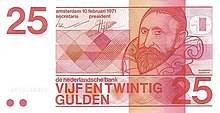erflatersserie
Jump to navigation
Jump to search
Dutch[edit]

Etymology[edit]
Compound of erflater (“someone who leaves an inheritance, bequeather, testator”) + -s- + serie (“series”), referring to the book Erflaters van onze beschaving ("Bequeathers of Our Civilisation") by Jan Romein and Annie Romein-Verschoor, a collection of biographies of Dutch historical figures, which was used by the Dutch central bank as a shortlist of characters eligible to be portrayed on banknotes.
Pronunciation[edit]
Noun[edit]
erflatersserie f (plural erflatersseries)
- (Netherlands) one of two series of Dutch banknotes featuring portraits of prominent characters from Dutch history issued in the 1950s-70s, designed by Eppo Doeve and Ootje Oxenaar, respectively.
- 1966 December 17, “Vijf guldenbiljet[sic] nog vóór Kerstmis [Five guilder note in time for Christmas]”, in Algemeen Dagblad[1], retrieved 21 February 2024:
- Het „vijfje“ is ontworpen door de Haagse kunstenaar D. Oxenaar. De hoofdkleur is groen. Omdat het biljet moest passen in de zogenaamde erflatersserie staat er een portret van Vondel op. Op de achterkant staat een afbeelding van de Amsterdamse schouwburg in Vondels tijd.
- The "fiver" was designed by the artist D. Oxenaar from The Hague. The main colour is green. As the note had to fit into the so-called Bequeathers' Series, it features a portrait of Vondel. On the back is an image of the Amsterdam Theatre in Vondel's time.
- 1999 August 28, Arend Evenhuis, “Nooit meer een zonnebloem, ijsvogel of stekelbaarsje [Never again a sunflower, kingfisher, or stickleback]”, in Trouw[2], retrieved 21 February 2024:
- Oxenaar bouwde vanaf 1970 voort op de erflatersserie met zijn biljetdebuut Vondel (5 gulden), vervolgens Frans Hals (10), Sweelinck (25), Michiel de Ruyter (100) en Spinoza (1000). Was het geharrewar om een al dan niet mannelijke, vrouwelijke, katholieke, agnostische of prostestantse erflater eindelijk afgehandeld, dan wachtte de verbeelding van de verkoren historische held nog.
- Starting in 1970, Oxenaar built on the Bequeathers' Series with his debut Vondel note (5 guilders), followed by Frans Hals (10), Sweelinck (25), Michiel de Ruyter (100) and Spinoza (1000). Once the wrangling over whether [to depict] a male, female, Catholic, agnostic, or Protestant 'bequeather' was finally settled, [designing] the representation of the chosen historical hero still awaited.
- 2001 September 17, H. de Boer, “„De euro is een verarming”. Kunsthal Rotterdam brengt vier maanden ”Hulde aan de gulden” ["The euro represents a debasement". Kunsthal Rotterdam offers four months of "Homage to the guilder"]”, in Reformatorisch Dagblad[3], retrieved 21 February 2024:
- In een tijdstunnel prijken afbeeldingen van alle munten en biljetten die sinds de invoering van het decimale stelsel in 1816 zijn geslagen en gedrukt. (...) Tempel: „In de tunnel kun je zien hoe oud mensen zijn. Mijn oma zal direct op zoek gaan naar het tientje van Lieftinck, jongere mensen zullen vooral de erflatersserie van Oxenaar (de biljetten met portretten van onder anderen Joost van den Vondel, Frans Hals en Michiel Adriaanszoon de Ruyter, red.) herkennen.”
- A time tunnel displays images of all coins and notes minted and printed since the introduction of the decimal system in 1816. (...) Mr Tempel: "In the tunnel, you can tell what age people are. My grandmother will immediately start looking for the 'Lieftinck tenner', younger people will especially recognise Oxenaar's Bequeathers' Series (the notes with portraits of Joost van den Vondel, Frans Hals and Michiel Adriaanszoon de Ruyter, among others, ed.)."